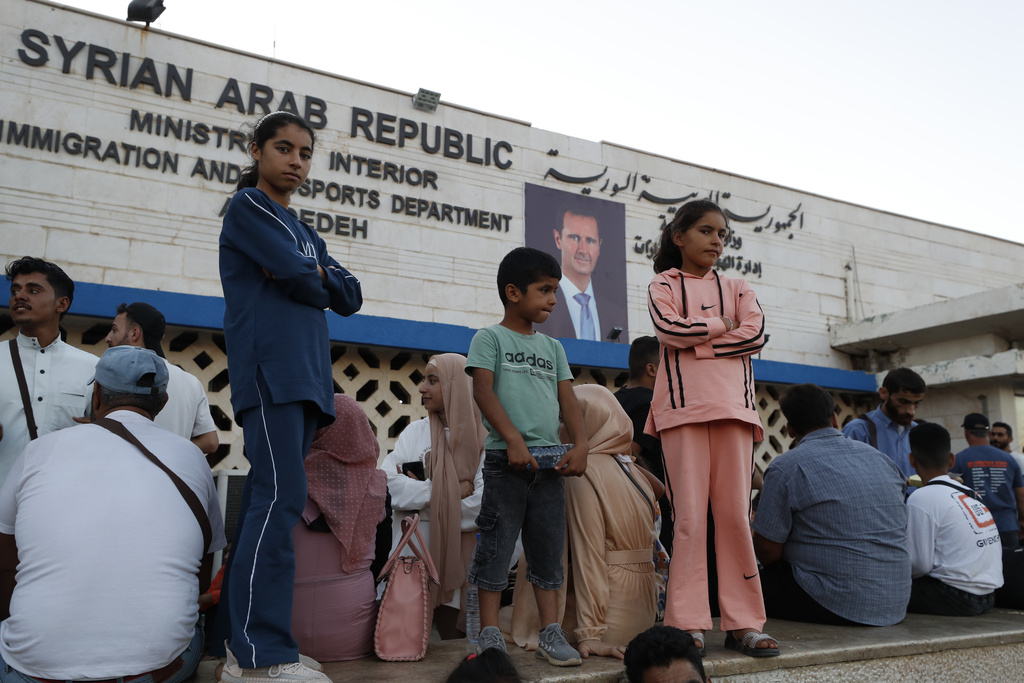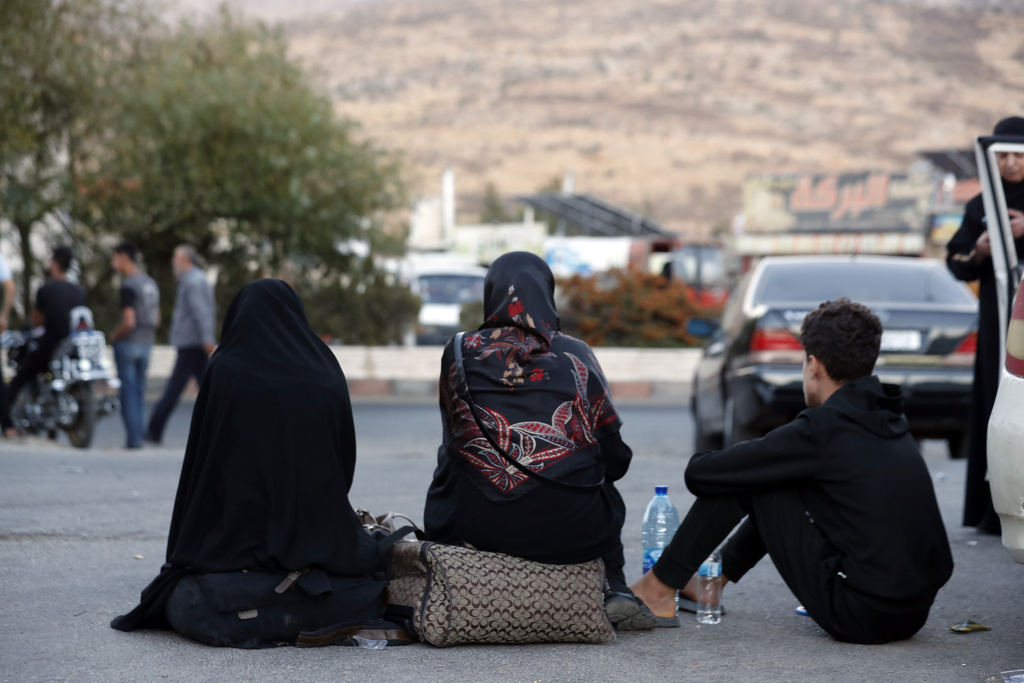Thousands Flee Lebanon Bombing, Seek Safety in Syria \ Newslooks \ Washington DC \ Mary Sidiqi \ Evening Edition \ As conflict escalates in Lebanon, thousands of families are fleeing into Syria despite its own war-torn status. U.N. officials estimate the number of refugees, including many women and children, will continue to grow as Israel intensifies its airstrikes. The refugee flow is a reversal, as Lebanon has hosted over one million Syrian refugees since 2011.

Lebanon Conflict Refugees Quick Looks:
- Thousands of Lebanese and Syrian families are fleeing into Syria as violence in Lebanon escalates.
- U.N. officials predict more refugees as Israel continues bombing southern and eastern Lebanon.
- Over 600 people have died this week in Lebanon, with a quarter being women and children.
- Long lines of buses, cars, and even pedestrians stretched for miles at the Syria border.
- Relief efforts are underway, with aid workers distributing food, water, and blankets to those crossing.
- Syrian refugees who previously fled their own civil war are now returning to their homeland.
- Many refugees reported waiting eight to nine hours to cross into Syria.
- Lebanese citizens can enter Syria without a visa, making it an accessible refuge amid the crisis.
- The influx has overwhelmed Syrian border officials, leading to long wait times for processing.
- Syrian citizens crossing back are required to convert $100 into Syrian pounds, further straining the border resources.
Deep Look:
Families fleeing the escalating conflict in Lebanon have been pouring into Syria in increasing numbers, seeking refuge from the intense Israeli bombardment. Long lines of buses, cars, and even people traveling on foot formed at the Syria-Lebanon border on Wednesday, marking a grim reversal for a region where Lebanon had previously been a safe haven for millions of Syrian refugees. Now, the roles are reversed as Lebanon itself becomes a dangerous war zone.
U.N. officials estimated that thousands of families, both Lebanese and Syrian, had already crossed into Syria by midweek. These numbers are expected to rise as Israel continues its aerial strikes, which have focused on southern and eastern Lebanon, reportedly targeting Hezbollah militants. According to local officials, more than 600 people have been killed in Lebanon this week alone, and at least a quarter of the casualties are women and children. Israel maintains that its strikes are aimed at Hezbollah fighters and their weapons caches.
As families flee their homes, the border crossings have become congested. Beginning on Monday, lines of vehicles stretched for several kilometers from the Syrian border, and in many cases, desperate families were forced to walk. Once they reached Syria, the situation remained dire as border officials, overwhelmed by the influx, struggled to process the refugees. Aid workers distributed food, water, mattresses, and blankets, but many families had no choice but to sleep outdoors, waiting their turn to cross.
Rula Amin, a spokesperson for the U.N.’s refugee agency, confirmed that some refugees arriving from Lebanon bore visible injuries from the recent airstrikes. “Many will have to spend the night outdoors waiting their turn,” Amin noted in a statement, underscoring the urgency of the situation.
The mass migration into Syria is a stark reversal of the recent past, where Lebanon had been a refuge for over one million Syrians fleeing their country’s civil war, which erupted in 2011. What began as a peaceful uprising against the Syrian government turned into a brutal, ongoing conflict after a harsh crackdown by Syrian authorities. Many of those now fleeing Lebanon had been living in the country for years as refugees from that very war.
In the Syrian border town of Jdeidet Yabous, Associated Press journalists observed families sitting by the roadside, waiting for transport or relatives to collect them. Some used their luggage as makeshift seats, having already spent hours in traffic trying to cross into Syria. Many refugees reported traveling for eight or nine hours, stuck in long lines just to enter the war-torn country.
Crossing the border also presented new challenges for those returning to Syria. Before entering, crowds packed into government offices to be processed by immigration officers. Syrian citizens were required to convert $100 into Syrian pounds—a rule designed to prop up the struggling Syrian currency. However, due to the sudden surge in refugees, the supply of Syrian pounds quickly ran short, leaving many in limbo.
Among the refugees were individuals like Emad al-Salim, who had fled Aleppo in 2014 during the height of Syria’s civil war. After settling in the southern Lebanese city of Tyre, he was forced to flee once again when Israel’s bombardment began on Monday. “There were houses destroyed in front of me as we were coming out,” al-Salim said, recounting the devastation. His journey took three days, as he, his wife, and their six children sought safety in Syria.
Others, like Nada Hamid al-Lajji, returned to Syria after living in Lebanon for seven years with her husband. Although they are from eastern Syria, al-Lajji expressed uncertainty about where they will go next. “I don’t even have a house anymore. I don’t know where I will go,” she said, reflecting the despair felt by many refugees facing an uncertain future.
Many Lebanese families also sought refuge in Syria, including Mahmoud Ahmad Tawbeh, who fled from the southern village of Arnoun with an extended family of 35 people. Tawbeh described how bombs fell as they left their village. Several houses were destroyed, and many neighbors were killed, he said. His family plans to stay in a rented house in a Damascus suburb for the time being.
For Lebanese families, particularly those in the Bekaa Valley to the east, Syria is seen as the nearest and most accessible safe zone. Israel’s strikes across the country have injured over 2,000 people, adding to the urgency for those seeking escape.
Despite the ongoing war in Syria, fighting has largely stalled in many parts of the country, making it a comparatively safer option for those fleeing the violence in Lebanon. Lebanese citizens, who do not require a visa to enter Syria, have regularly crossed the border for work or family reasons. In fact, even before the recent escalation, some Lebanese had already rented apartments in Syria as a contingency plan in case they needed to evacuate.
However, many Syrian refugees have been reluctant to return to their homeland out of fear of arrest for perceived opposition ties or the threat of forced conscription into the Syrian army. Returning to Syria also jeopardizes their refugee status, which many are unwilling to risk.
In a bid to encourage refugees to return, Syrian President Bashar al-Assad issued an amnesty earlier this week, pardoning those who evaded compulsory military service before September 22. Similar amnesties have been announced in the past but have had limited success in persuading refugees to go back, as fear of government retribution remains strong. Efforts by Lebanese authorities to organize “voluntary return” trips have also largely failed.







